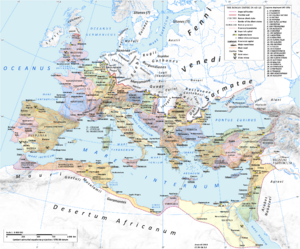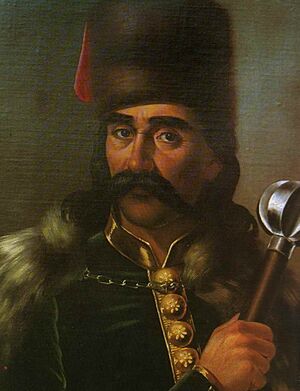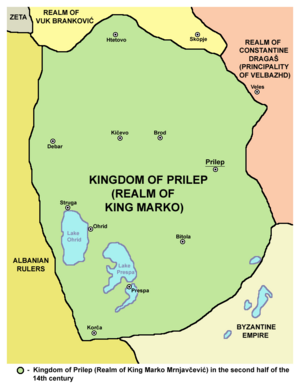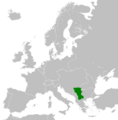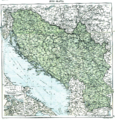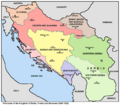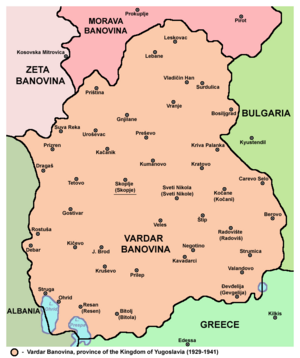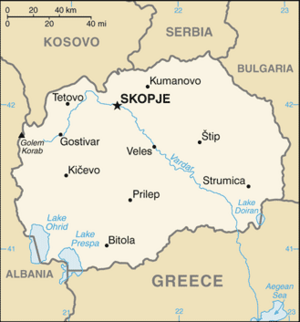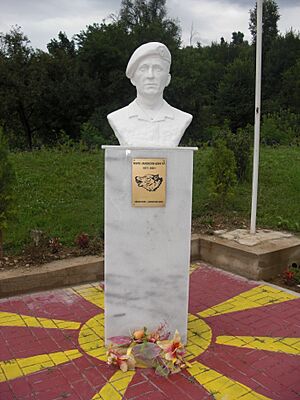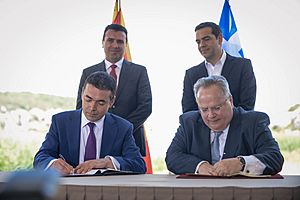History of North Macedonia facts for kids
The history of North Macedonia is about the land where the country of North Macedonia is today. This area has a very long and interesting past, with many different groups of people living here and many empires ruling over it.
Contents
Ancient Times
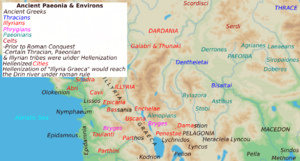
Early Tribes and Kingdoms
Long ago, much of what is now North Macedonia was part of a kingdom called Paeonia. People called Paeonians, who were related to the Thracians, lived there. Other parts of the land were home to ancient Illyrians and ancient Greeks. These groups didn't have fixed borders. Sometimes, they were ruled by the Kings of Macedon, and sometimes they were independent.
Persian and Roman Rule
Around 500 BC, the powerful Persian Empire took control of the Paeonians. This meant North Macedonia became part of a huge empire! But after losing a big war in Greece in 479 BC, the Persians left.
Later, in 336 BC, Philip II of Macedon conquered this area. His son, Alexander the Great, then built an even bigger empire that included most of the region. After Alexander, the Roman Empire took over. Most of North Macedonia became part of the Roman province of Macedonia.
Medieval Times
Arrival of Slavs
Before the 5th century AD, not much is known about the Slavs. The people living here were mostly of Roman or Greek background. But starting in the 6th century, South Slavic tribes began to settle in the land that is now North Macedonia. Byzantine (Eastern Roman Empire) historians called these Slavic settlements "Sclavenes." These Sclavenes often attacked the Byzantine Empire, sometimes with help from the Bulgars or Avars.
Around 680 AD, a group of Bulgars, led by Khan Kuber, settled in the Pelagonian plain. They even launched attacks towards the city of Thessaloniki. The Byzantine emperors tried to control the Slavs, moving many of them to other parts of their empire.
Changing Rulers
After about 836 AD, the Slavs in the Macedonia region became part of the First Bulgarian Empire. The Bulgars and Slavs mixed, and the Slavs adopted the Bulgarian language and identity. This state grew strong and took over the entire region by 837 AD.
Two important figures, Saints Cyril and Methodius, who were Greek and born in Thessaloniki, created the first Slavic alphabet (Glagolitic) and the Old Church Slavonic language. Their work was very important for Slavic culture. In medieval Bulgaria, the region of Ohrid became a major religious and cultural center. A student of Cyril and Methodius, Saint Naum, helped create a famous school in Ohrid where thousands of students learned the Glagolitic and later Cyrillic scripts.
By the late 10th century, much of North Macedonia became the center of the First Bulgarian Empire under Tsar Samuel. The capital was moved to Ohrid. But in 1018, the Byzantine Empire took control of Bulgaria, including North Macedonia. The region became a Byzantine province called Theme of Bulgaria.
In the 13th and 14th centuries, the area was sometimes ruled by the Byzantines, sometimes by the Bulgarians, and sometimes by the Serbians. For example, Skopje became the capital of the Serbian Empire under Stefan Dušan. After this empire broke apart, local Serbian rulers like Prince Marko controlled parts of the region. Prince Marko's capital was Prilep. He later became a vassal (a ruler who owes loyalty to a more powerful one) of the Ottoman Empire.
Parts of western North Macedonia were also ruled by Albanian noble families, like the Gropa family and the Kastrioti family. The famous Albanian leader Skanderbeg fought many battles against the Ottomans in this region in the 15th century, trying to keep it free. However, after Skanderbeg's death in 1468, the Albanian resistance weakened, and the Ottomans eventually took full control.
Ottoman Rule
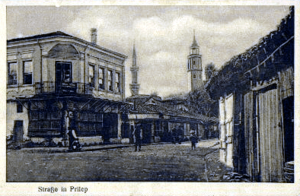
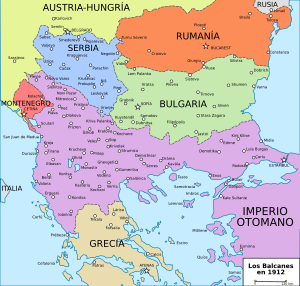
The Ottoman Empire conquered the region at the end of the 14th century. It remained under Ottoman rule for over 500 years! The area was part of a large Ottoman province called Rumelia, which means "Land of the Romans" in Turkish. Over time, Rumelia became smaller. By the 19th century, the territory of North Macedonia was divided into different Ottoman provinces, with important cities like Skopje and Bitola serving as capitals.
During Ottoman rule, many Turkish people settled in the region, and some locals converted to Islam. Before the First Balkan War in 1912, the Ottomans ruled the Vardar river valley, which is the central part of North Macedonia today. There was a brief time in 1878 when it was freed and became part of Bulgaria, but it soon returned to Ottoman control. In 1903, a short-lived Kruševo Republic was declared by rebels.
Many people who studied the region during Ottoman times believed that the Slavic-speaking people in Macedonia were Bulgarians. However, they also noted that the language spoken in Macedonia was a bit different, often called a "Western Bulgarian dialect." Some Macedonian Slavs, especially in the north, saw themselves as Serbs. In the south, some wanted to join Greece. It's important to remember that in medieval times, ethnic identity wasn't as fixed as it is today.
During the Bulgarian National Revival (1762–1878), many Bulgarians from Vardar Macedonia supported creating Bulgarian cultural and religious groups. Later, the Macedonian Struggle (1893–1908) tried to gain more rights for the people but didn't fully succeed.
Kingdom of Yugoslavia (1912–1944)
Balkan Wars and World War I
In 1912, during the First Balkan War, the Kingdom of Serbia took control of the region. It was then added to Serbia and called "South Serbia" or "Old Serbia." The Strumica region was part of Bulgaria for a few years. During World War I, Bulgaria occupied the area from 1915 to 1918. After the war, Serbia joined with other lands to form the new Kingdom of Serbs, Croats and Slovenes.
-
Skopje after being captured by Albanian revolutionaries in August 1912.
Royal Yugoslav Period
After World War I, the Slavic people in this part of Serbia were seen as southern Serbs, and their language as a Serbian dialect. Bulgarian, Greek, and Romanian schools were closed, and non-Serbian teachers were sent away. This policy of making everyone more Serbian caused problems, especially with groups like the Internal Macedonian Revolutionary Organization (IMRO) who wanted a separate Macedonia.
In 1929, King Alexander I took full control of the government. He renamed the country the Kingdom of Yugoslavia and divided it into provinces called "banovinas." The territory of what is now North Macedonia became the Vardar Banovina, with Skopje as its capital. King Alexander's rule was very strict, and he was later assassinated in 1934.
World War II
During World War II, from 1941 to 1944, the Vardar Banovina was divided. Italian-ruled Albania took the western parts where many Albanians lived, and pro-German Bulgaria occupied the rest. People who opposed these rulers joined the Communist resistance movement led by Josip Broz Tito. Many local people, especially in the Bulgarian-occupied areas, even joined the Bulgarian army.
Socialist Yugoslavia (1944–1991)
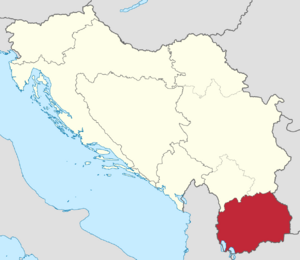
After World War II, Yugoslavia became a federal state under Tito's Communist Party. In 1944, most of the former Vardar province became a separate republic within Yugoslavia. In 1946, it was officially named the "People's Republic of Macedonia." Later, in 1963, it was renamed the "Socialist Republic of Macedonia."
The Yugoslav government worked to develop a distinct Macedonian identity and language. The Macedonian language was officially recognized in 1944. This made Greece and Bulgaria unhappy because they worried about possible claims to their own parts of the historical Macedonia region.
During the Greek Civil War (1944–1949), many Macedonians fought with the Communist-led resistance in Greece. After the war, Greece did not allow all these fighters to return home, especially those who identified as Bulgarian or Macedonian Slavs. This caused tensions between Yugoslavia and Greece.
Independence
The 1990s
In 1990, the country peacefully changed from a socialist state to a parliamentary democracy. The first multi-party elections were held that year. Kiro Gligorov became the first democratically elected president in 1991. On April 16, 1991, the parliament removed "Socialist" from the country's name, making it the "Republic of Macedonia."
On September 8, 1991, the country held a vote for independence from Yugoslavia. A huge 95.26% voted for independence! The question was: "Would you support independent Macedonia with the right to enter a future union of sovereign states of Yugoslavia?" On September 25, 1991, the Macedonian Parliament officially declared independence. A new Constitution of the Republic of Macedonia was adopted on November 17, 1991.
After Yugoslavia broke up, the position of ethnic Albanians in the new republic was unclear. Albanian political parties formed, asking for better rights, like more education in Albanian and changes to the constitution. Some even declared a "Republic of Ilirida" in 1992, but the Macedonian government said this was against the constitution.
Bulgaria was the first country to recognize the new Macedonian state. However, other countries were slow to recognize it because Greece objected to the name "Macedonia." Greece felt this name belonged to its own region and symbols. To solve this, the country was admitted to the United Nations in 1993 under the temporary name "the former Yugoslav Republic of Macedonia."
Greece was still not happy and put a trade blockade on the country in 1994. The blockade was lifted in 1995 after Macedonia changed its flag and parts of its constitution that Greece found problematic. While relations improved, the name issue remained a big debate. Many countries recognized the country as the "Republic of Macedonia," while others used the temporary UN name.
In 1999, the Kosovo War caused 340,000 Albanian refugees from Kosovo to flee into the Republic of Macedonia. This greatly affected daily life and created tension between Macedonians and Albanians. The country did not get involved in the conflict itself.
The 2000s and Beyond
In spring 2001, ethnic Albanian rebels, calling themselves the National Liberation Army (NLA), started fighting in the north and northwest. They wanted the constitution to be changed to give more rights to the Albanian minority, such as language rights. The fighting was mainly around Tetovo, Skopje, and Kumanovo.
After talks involving the European Union, a cease-fire was agreed upon in June 2001. The government promised more civil rights for Albanians, and the NLA agreed to give up their weapons to NATO soldiers. NATO's "Operations Essential Harvest" collected the weapons in August 2001, and the NLA officially disbanded. Relations between ethnic groups have improved since then, though some small incidents still happen.
On February 26, 2004, President Boris Trajkovski died in a plane crash. The investigation showed that mistakes by the crew caused the accident.
In March 2004, the country applied to join the European Union. In 2005, it was listed as a candidate country. However, joining the EU was delayed because of Greece's opposition over the name dispute, and later by Bulgaria due to disagreements about history.
In June 2017, Zoran Zaev became the new Prime Minister, ending 11 years of conservative rule. In June 2018, the Prespa agreement was signed between Greece and the Republic of Macedonia. This agreement changed the country's name to the Republic of North Macedonia, or simply North Macedonia. This agreement officially took effect on February 12, 2019, finally ending the long-standing name dispute.
Stevo Pendarovski became North Macedonia's new president in May 2019. Zoran Zaev served as Prime Minister again from August 2020 but resigned in October 2021. Dimitar Kovačevski then became the Prime Minister in January 2022.
See also
 In Spanish: Historia de Macedonia del Norte para niños
In Spanish: Historia de Macedonia del Norte para niños
- Breakup of Yugoslavia
- History of Albania
- History of the Balkans
- History of Bulgaria
- History of Europe
- History of Greece
- History of Kosovo
- History of Serbia
- History of Turkey
- History of Yugoslavia
- Macedonia (region)
- Macedonian nationalism
- United Macedonia
- Military history of North Macedonia
- Independent State of Macedonia
- League of Communists of Yugoslavia
- President of the Republic of North Macedonia
- List of prime ministers of North Macedonia
- List of presidents of Yugoslavia
- List of prime ministers of Yugoslavia
- Politics of North Macedonia


